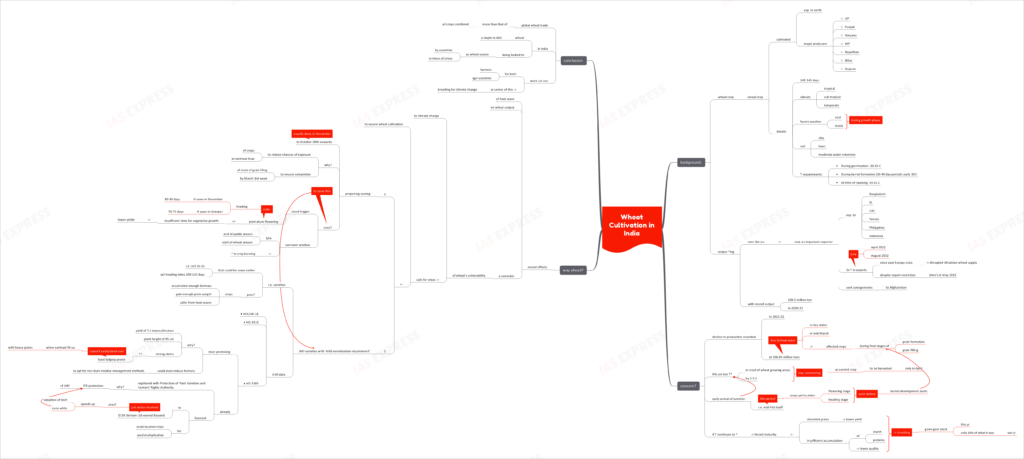Wheat Cultivation in India- Breeding for Climate Change

In light of the rising temperatures in the north, the Agriculture Ministry recently announced the setting up of a committee to monitor the situation and its implications for wheat cultivation. Rising mercury levels is raising fears of another wheat season falling victim to heat waves.

Background:
- Wheat is an important cereal crop cultivated in India, especially in the north.
- Its cultivation takes 140-145 days.
- It can be cultivated in tropical, sub-tropical and temperate regions.
- Cool and moist weather during the growth phase is favourable.
- Clay or loamy soil with moderate water retention capacity is ideal.
- Temperature requirement:
- During germination: 20-25 C
- During kernel formation (30-40 day period): early 30 C
- At time of ripening: 14-15 C
- The major wheat producers are:
- UP
- Punjab
- Haryana
- MP
- Rajasthan
- Bihar
- Gujarat
- In over the years, wheat production has been increasing in India, with a record 109.5 million ton output in 2020-21.
- It now produces enough to become an important exporter. Some of the major importers of Indian wheat are Bangladesh, Sri Lanka, UAE, Yemen, Philippines and Indonesia.
- Notably, India exported several consignments of wheat to Afghanistan, as part of its humanitarian assistance.
- Also, in light of the east European crisis disrupting wheat supply from Ukraine, India’s wheat exports doubled between April and August 2022. This happened despite an export restriction being introduced in May.
Why is there a concern this year?
- While India has been breaking records in terms of wheat output, note that the 2021-22 crop year saw a decline in production- to 106.84 million tons due to heat wave conditions in key states. The mid-March temperature surge affected the crops in their final stage of grain formation and filling.
- Again, this year, the temperature in most of the wheat growing areas is 3-5 C above normal. This is a major concern as the current crop would be harvested only in April.
- Worryingly, the early arrival of summer i.e. higher than normal temperatures are being recorded from mid-February itself – a time when the crops are yet to properly enter the flowering and heading stage, even before the kernel development starts.
- If the temperatures continue to increase, it would trigger forced maturity resulting in shrivelled grains. This means lower yields.
- The grains wouldn’t have enough time to accumulate sufficient components, like starch and protein, thus reducing their quality as well.
- This would be a troubling outcome, especially given how the government’s stock is half of what it was last year.
What is the way ahead?
- The recent effects of heat wave on wheat output is a reminder of the crop’s vulnerability to climate change. This calls for steps to secure wheat cultivation:
- Preponing sowing:
- ICAR scientists have suggested preponing the sowing of wheat. While it is generally sowed in November, starting sowing from October 20th onwards could reduce the chances of the crops being exposed to terminal heat and ensure that most of the grain-filing phase is completed by the 3rd week of March.
- However, this preponing could trigger premature flowering without leaving sufficient time for vegetative growth, leading to lower yields. Note that crops sown in November take 80-95 days to come to heading while those sown in October, it does so in 70-75 days.
- Shifting the sowing period to October may present a challenge in terms of a shorter window post-paddy season in Punjab and Haryana. Already, the low window is pushing many farmers to resort to stubble burning to prepare the fields for wheat season.
- IARI’s wheat varieties with ‘mild vernalisation requirement’:
- These varieties have been bred in such a way that even when sown in the period between October 20th and 25th, it takes 100-110 days to come to heading.
- This enables the crops to accumulate enough biomass and grain weight.
- 3 such varieties have been developed:
- HDCSW-18
- HD-3410
- HD-3385
- Of these, the HD-3385 variety is considered the most promising, with a yield of 7.5 tonnes/hectare and a plant height of 95 cm. Its strong stems mean that it is the least lodging-prone (i.e. doesn’t easily bend over when earheads are filled with heavy grains).
- This variety has already been registered by the IARI with the Protection of Plant Varieties and Farmers’ Rights Authority, for protection of intellectual property rights.
- DCM Shriram Ltd-owned Bioseed has been licensed to undertake trials in multiple locations and also seed multiplication.
- This involvement of private sector is expected to expedite the adoption of this technology, even while protecting IARI’s IPR.
- If the HD-3385 field trials are successful, it may even induce farmers to opt for non-burn residue management methods.
- Preponing sowing:
Conclusion:
The global wheat trade is more than that of all other crops combined. Wheat has been a staple of the Indian diet and the country is being increasingly looked to as a source of the grain during international crises. Both the farmers and the agricultural scientists have their work cut out, the core of which is breeding for climate change.
Practice Question for Mains:
In view of the recent impact of heat waves on wheat production, comment on the need to ‘breed for climate change’. (250 words)
If you like this post, please share your feedback in the comments section below so that we will upload more posts like this.

